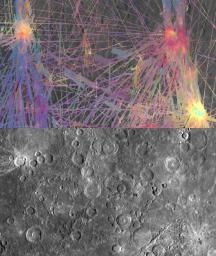The top image is a MASCS VIRS instrument color composite over a region of cratered plains on Mercury that includes craters Mena (upper left), Cezanne, Philonexus, Chu Ta, and the unnamed "blue tongue" impact crater (lower right). Below is a contrast enhanced version of the MDIS mosaic without the VIRS overlay. In the VIRS color composite, the young rays of Mena and the blue tongue crater appear in yellows and oranges. Other colors in the VIRS composite are related to degree of space weathering and iron content of the surface materials.
The VIRS composite shows hundreds of individual footprints compiled over dozens of orbits, with MESSENGER viewing the surface from different directions and at different altitudes. In locations where multiple footprints cover the same area, the footprint with the best illumination for mineralogical interpretation (usually the lowest incidence angle where shadows are minimized) is used for making the map. In the MDIS mosaic some brightness variation are due to tiling of images taken at different illuminations.
Date Created: April 24, 2012
Instruments: Visible and Infrared Spectrograph (VIRS) of the Mercury Atmosphere and Surface Composition Spectrometer (MASCS), and Mercury Dual Imaging System (MDIS)
VIRS Color Composite Wavelengths: 575 nm as red, 415 nm/750 nm as green, 310 nm/390 nm as blue
Center Latitude: -4.5°
Center Longitude: 244.7° E
Resolution: 1 km/pixel
Scale: Crater Mena (upper left of mosaics) is 15 km (9 mi) across
The MESSENGER spacecraft is the first ever to orbit the planet Mercury, and the spacecraft's seven scientific instruments and radio science investigation are unraveling the history and evolution of the Solar System's innermost planet. Visit the Why Mercury? section of this website to learn more about the key science questions that the MESSENGER mission is addressing. During the one-year primary mission, MDIS acquired 88,746 images and extensive other data sets. MESSENGER is now in a year-long extended mission, during which plans call for the acquisition of more than 80,000 additional images to support MESSENGER's science goals.
These images are from MESSENGER, a NASA Discovery mission to conduct the first orbital study of the innermost planet, Mercury. For information regarding the use of images, see the MESSENGER image use policy.

 Planetary Data System
Planetary Data System












